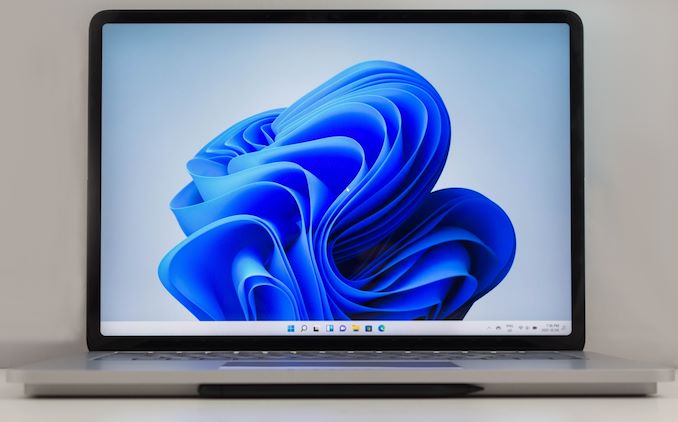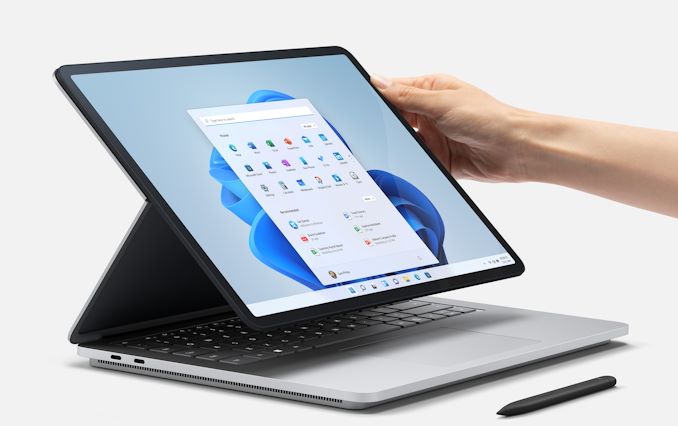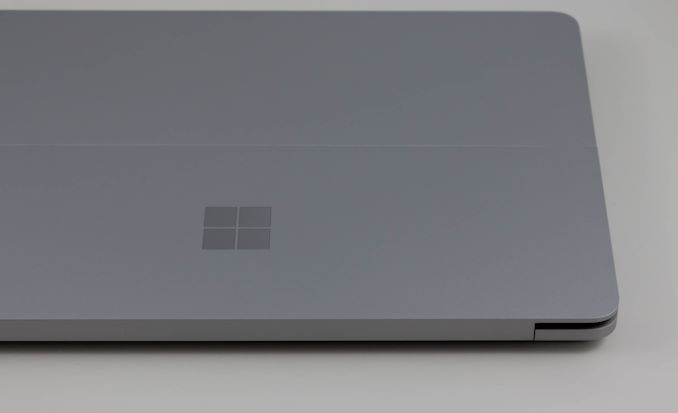The Microsoft Surface Laptop Studio Review: Dynamic Design
by Brett Howse on October 5, 2021 9:00 AM EST- Posted in
- Laptops
- Microsoft
- Surface
- Surface Laptop Studio

Microsoft’s Surface team has produced some amazing designs over the years, taking to focusing on convertible devices to highlight the adaptability of Windows. That being said, over the last several years the design team has been largely held in check, as Microsoft has opted to focus on further refining their convertible designs. Thankfully, for 2021 the team is back to innovation as well as refinement with their latest device, the Surface Laptop Studio. With its dynamic woven hinge, the Laptop Studio is a true convertible device, as well as the spiritual successor to the now-defunct Surface Book.
The Surface Laptop Studio’s unique feature is most certainly the tiltable display. And while the idea of being able to tilt the display on a laptop is not unique, Microsoft’s dynamic woven hinge is. The hinge mechanism provides the ability to convert the laptop into three modes, which Microsoft is calling Laptop, Stage, and Studio modes. The genius of the design though is that Microsoft’s hinge provides these modes without a significant amount of bulk, so unlike most convertible devices, the extra functionality does not come at the cost of compromising the laptop experience. The Surface Laptop Studio is first and foremost a laptop computer, and not conceding that capability to add the extra functionality is a big win.
As a successor to the Surface Book, performance is also a key in the Surface Laptop Studio. To that end, it is equipped with Intel’s H35-series 11th Gen Core processors – a higher powered version of Intel’s quad-core “Tiger Lake” CPUs, along with their Iris Xe integrated graphics. And with the Core i7 model Microsoft goes one step further by adding a discrete GPU; either NVIDIA GeForce RTX 3050 Ti for consumer models, or if you opt for a commercial model, the professional-focused RTX A2000. For memory, the base model comes with 16 GB of LPDDR4x with a 32 GB option on the i7. On the storage front Microsoft offers from 256 GB to 2 TB of PCIe 3.0 solid state storage, which is also user replaceable.
All of this drives the new 14.4-inch PixelSense Flow display. The exciting news here is that the Surface Laptop Studio features a 120 Hz display to improve the laptop's smoothness and responsiveness. At a 2400x1600 resolution, the panel is not quite as high density as the outgoing Surface Book, but still offers a respectable 201 pixels per inch.
| Surface Laptop Studio As tested: Core i7 / RTX 3050 Ti / 32 GB / 1TB / $2699.99 |
|||||
| Component | Core i5 | Core i7 | |||
| CPU | Core i5-11300H 4 core 8 Thread 3.1-4.4 GHz 35W TDP |
Core i7-11370H 4 core 8 Thread 3.3-4.8 GHz 35W TDP |
|||
| GPU | Intel Iris Xe 1.3 GHz 80 Execution Units |
Intel Iris Xe 1.35 GHz 96 Execution Units NVIDIA RTX 3050 Ti/RTX A2000 4GB GDDR6 128-bit 2560 CUDA Cores 80 Tensor Cores 20 Ray Tracing Cores 32 ROPS |
|||
| RAM | 16 GB LPDDR4x | 16GB / 32GB LPDDR4x | |||
| Storage | 256GB / 512GB PCIe | 512GB / 1TB / 2TB PCIe | |||
| Display | 14.4-inch PixelSense Flow LCD 2400x1600 (201 PPI) 120 Hz variable refresh 3:2 aspect ratio Dolby Vision Support |
||||
| Networking | Intel Wi-Fi 6 AX200 Bluetooth 5.1 |
||||
| I/O | 2 x Thunderbolt 4 Surface Connect Headset jack |
||||
| Camera | 1080p webcam Windows Hello 2.0 IR |
||||
| Battery | 56 Wh 65W AC Adapter (5W for USB-A charging) |
56 Wh 102W AC Adapter (7W for USB-A charging) |
|||
| Dimensions | 323 x 229 x 17.8 mm 12.7 x 9.0 x 0.7 inches |
||||
| Weight | 1.74 kg / 3.83 lbs | 1.82 kg / 4.00 lbs | |||
| Starting Price (USD) | $1,599.99 | $2,099.99 | |||
The Surface team has been slow to adopt USB-C on their products, and when they did finally acquiesce to the demand, they chose not to enable Thunderbolt in their past products. Thankfully, for the Surface Laptop Studio, they have finally changed their stance. The Surface Laptop Studio now features two Thunderbolt 4 ports for expansion, as well as the now-traditional Surface Connect port for charging and docking. This finally brings Surface up to modern times, although there will likely be some that are disappointed to see USB Type-A ports dropped entirely. With the design of Surface Laptop Studio, there just is not room for the larger port. What would have been nice to see is the included Type-A charging port built into the charger also allow data, but that is not the case. Still, if there is one thing Surface has been called out on in the past it was their port selection, so it is nice to see the most modern options here on the new design.
It should come as no surprise to see Wi-Fi 6 support, powered by the Intel AX200 adapter. Although it is a bit of a surprise to not see the newer AX210 with Wi-Fi 6E support, since it is the latest model.
Microsoft calls the Surface Laptop Studio the successor to the Surface Book, which was their previous performance notebook. With an optional GPU and 35-Watt Intel processors, the Surface Laptop Studio is the most powerful Surface portable they have built. Let’s take a look at the design and see how it compares to its predecessors.












53 Comments
View All Comments
blppt - Thursday, October 7, 2021 - link
You think that's bad---my current Dell has on-chip Intel 620 and for some reason they also threw in the nearly useless MX130 from Nvidia as well. Talk about wasted silicon.Awells62 - Friday, October 8, 2021 - link
100% This is exactly why I canceled my order. Coming from my Surface Book 2 with a 1060... the 3050Ti isn't really that much of an upgrade, like an exceedingly minor upgrade compared to if they put a 3060 in there.amschroeder55 - Tuesday, October 5, 2021 - link
As a diehard lover of the SB lineup (still rocking that SB2 15 with 1060), I'm incredibly sad to see them go, particularly as it is finally feeling like good 15-25W cpu's are here/approaching to limit the need to go for a 35W (ala Zen 3 or otherwise), and honestly I think this folding hinge is a serious step back in ID, but I recognize it seemed inevitable when the gaps between models had been farther and farther apart.lemurbutton - Tuesday, October 5, 2021 - link
These laptops should be worse less than the M1 Macbook Air. At $1600 and $2,099.99, they're a joke.Wait for the M2X (A15-based) Macbook Pros coming out in a month.
lemurbutton - Tuesday, October 5, 2021 - link
worse --> worthZeratul56 - Tuesday, October 5, 2021 - link
The M1 is an impressive feat of cpu performance no doubt but to discount this computer on that alone is foolish.This offers a touch screen, pen input, optional internal graphics, and support for external graphics. It also has an articulating display in a form factor that is only 2 mm thicker than the Mac book pro.
You can say you don’t want or need any of those features which is fine but to say it’s a slam dunk for a MacBook Air is stupid.
Apple put out sub par cooling designs for their MacBook’s for year and now that the M1 exists suddenly every apple fanboy loves absolute cpu performance.
Byte - Tuesday, October 5, 2021 - link
For now the Macbooks are glorified ipads with keyboards. They just throw away decades of programs. I may be a MS whore, but I do run iPhones only and iPads. I guess it is fitting Apple will just do their own thing and you have to go MS or Linux to do real work.misan - Wednesday, October 6, 2021 - link
This doesn't make any sense. No software has been thrown away (all old Intel apps works) and major stuff already natively works on ARM anyway. My entire dev and data science setup has been ARM native since early spring 2021.Findecanor - Wednesday, October 6, 2021 - link
Apple's CPUs have been more efficient/powerful than Intel's for years. It has taken this long for their software engineers to perfect x86-64 emulation.The M1 also employs a few unique tricks for making x86-64 emulation perform better.
gund8912 - Monday, October 11, 2021 - link
Like what softwares/programs ?